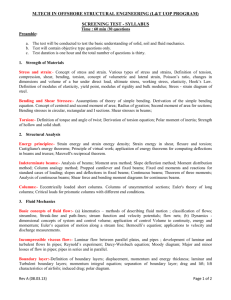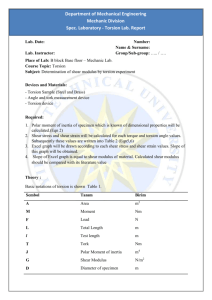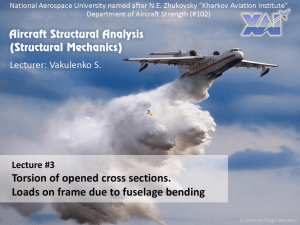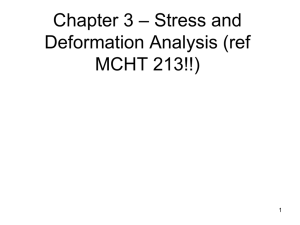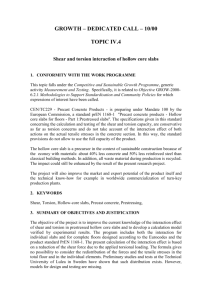Presentation Slides
advertisement
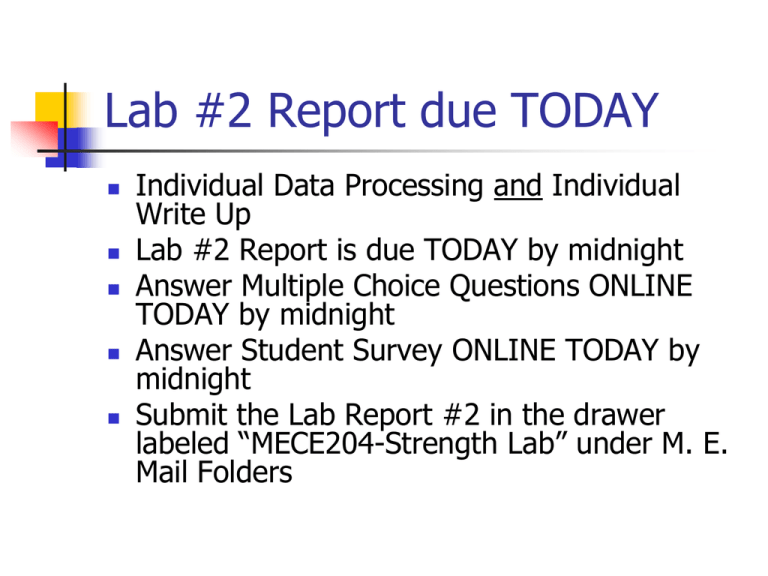
Lab #2 Report due TODAY Individual Data Processing and Individual Write Up Lab #2 Report is due TODAY by midnight Answer Multiple Choice Questions ONLINE TODAY by midnight Answer Student Survey ONLINE TODAY by midnight Submit the Lab Report #2 in the drawer labeled “MECE204-Strength Lab” under M. E. Mail Folders Torsion Testing Circular Cross-section Only Determine Material Properties in Torsion Draw Shear Stress-Strain Curve Ductile or Brittle Failure ? ASTM E-143 Test Method Compare results from Tensile, Poisson’s & Torsion Test Become familiar with Tinius Olsen Torsion Tester (10,000 in-lb capacity) Sign Convention Assumptions Perfectly linear-elastic behavior Circular x-section (solid or hollow) Small rotations Constant length Constant diameter No deformation A highly deformable member A circular x-section A grid of parallel circles and longitudinal lines on the outer surface After Deformation Two torques are applied Circles remain circles Longitudinal lines become twisted All angles are equal End x-section remains flat Angle of Twist A prismatic circular member Fixed at x = 0 Other end is FREE Loaded by a torque at the free end Angle (x) - angle of twist It depends on x: /x=constant Shear Strain Before After Shear Strain Distribution • • • • max = c max - occurs on the outer surface = (/c) max Result valid also for circular tubes within the material Valid for plastic deformation also 9 Shear Strain Distribution Shear Strain & Angle of Twist =*/L max = * D / 2 / L Shear Stress Distribution - Elastic Deformation only X-section: linear distribution Complimentary stresses in action Shear stress occur on axial planes (normal to the x-section 12 Shear Stress & Torque - Linear Elastic Deformation Only =T*/J max = T * D / 2 / J Shear Stress-Strain Curve Modulus of Rupture max, psi Slope = D/D = Shear Modulus, G max, rad Figure 3.2 Typical shear stress-strain diagram from a Torsion Test Linear Elastic Region – Shear Modulus Failure Surface – Tensile Testing Failure Surface – Torsion Test Brittle Failure – Torsion Test Stresses on an Inclined Plane in an Axially Loaded Member Seek for equilibrium after cutting along the oblique plane F 0: F 0: n N P cos( ) t V P sin( ) Area of theinclinedplaneis : An n A cos( ) NormalizeN and V with An to obtain the normaland shear stresses,respectively, t V P N on theinclinedplane(and notethat x P / A) : n x cos2 ( x / 2)(1 cos 2 ) nt x cos sin ( x / 2) sin 2 x Maximum Stress – Uniaxial Tension Comparing Tensile vs. Torsion Results Measuring Angle of Twist T=(R-R0)-(L-L0) Torsion Data Sheet Computing the Slip Angle Manually Recorded Data slip= H-(LH/LT)T T=(R-R0)-(L-L0) R0 L0 cor = H - slip Shear Strain and Stress =Radians(cor)*D/2/LH =16T//D3 Integrating Computer Data slip= constant cor=H - slip Selecting Computer Data Head Angle = 30.00 deg When Protractors taken OFF Max Torque = 1931 in-lb Entire Stress Strain Curve Elastic Curve Proportional Limit =G* Proportional Limit Plot columns H, I, & J Key Ideas - Torsion Shear strain formula is valid in both elastic & plastic region Torque formula is valid in linear elastic region ONLY Thus, shear stress formula is valid until proportional limit After proportional limit, shear stress formula overestimates stress. Torsion Results Comparing Tensile vs. Torsion Results Comparing Lab 1, 2, & 3 Experimental Results Lab #2 Report due TODAY Individual Data Processing and Individual Write Up Lab #2 Report is due TODAY by midnight Answer Multiple Choice Questions ONLINE TODAY by midnight Answer Student Survey ONLINE TODAY by midnight Submit the Lab Report #2 in the drawer labeled “MECE204-Strength Lab” under M. E. Mail Folders
